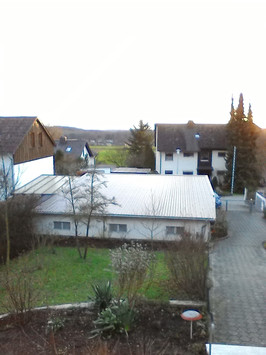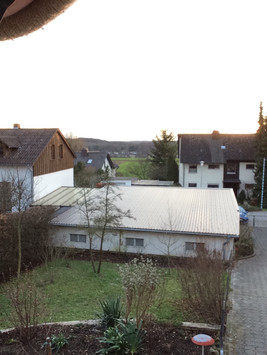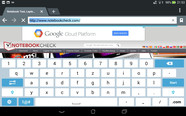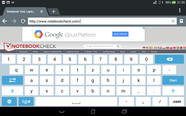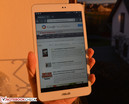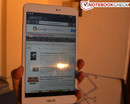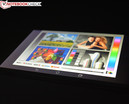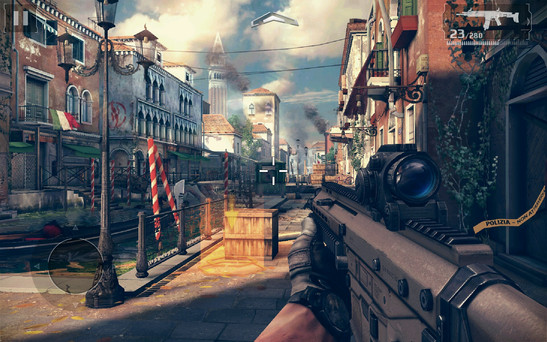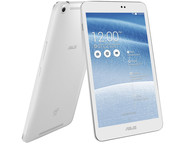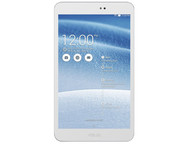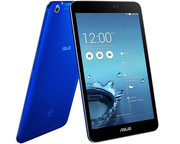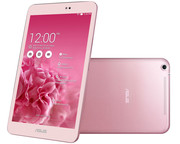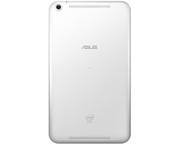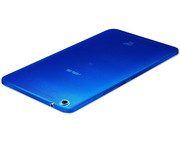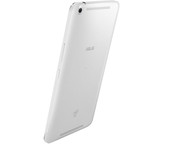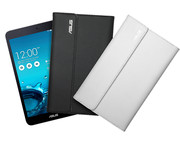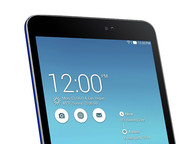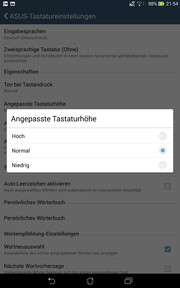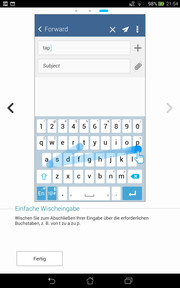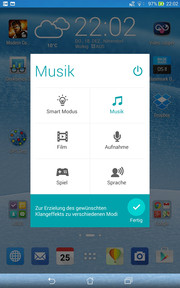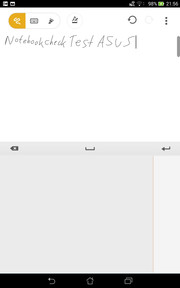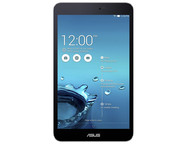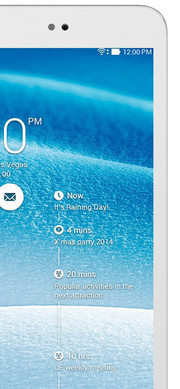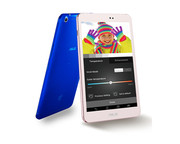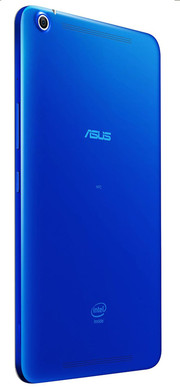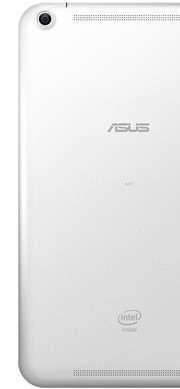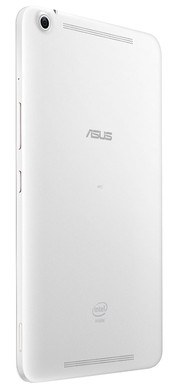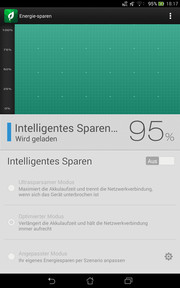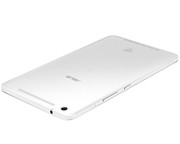Asus Memo Pad 8 ME581CL-1B027A Tablet Review
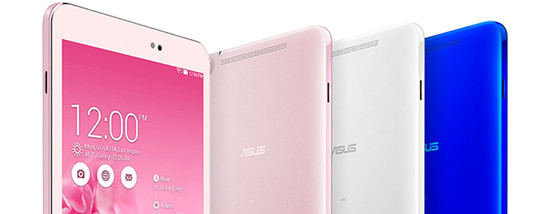
For the original German review, see here.
At last year's Computex Trade Fair in June, apart from the full-to-bursting data sheet of the Memo Pad 8 ME581CL, the Intel Atom Z3580 quad-core SoC with 2.3 GHz clock speed also came on the scene; the test product before us runs on a somewhat weaker Intel Atom Z3560 quad-core CPU with 1.83 GHz clock speed. Still, this marginal change of plans hardly does any harm to the tablet's quality. The changes to the Memo Pad 8 ME181CX (located below), designated a "Pro 7 Entertainment Pad," are as stark as expected, for which Asus demands nearly double the price. Apart from LTE and NFC, a zippy ac WLAN is also on board, as is a luminous 8-inch Full HD display with IPS technology and 16 GB of internal storage. The latter can be expanded up to 64 GB with a microSD card. With these specs, the Memo Pad 8 ME581CL must make for a potent competitor in the $350 price range, which also includes the Acer Iconia Tab 8 A1-840FHD, the Huawei MediaPad M1 8.0 and the Nvidia Shield Tablet LTE P1761. The Asus Fonepad 8 FE380CG steps up as a similarly equipped in-house competitor.
Case
The Asus Memo Pad 8's case consists of a glossy lacquered polycarbonate and looks quite elegant. Our test product is also available in glossy pink or blue, as desired. A negative side effect of this orgy of lacquer: The reverse side is very sensitive to smudging and susceptible to fingerprints, though it does seem to resist scratches very well. The tablet passes the torsion test with flying colors and withstands strong applications of force with only a bit of popping. Even high pressure from behind does not cause discolorations on the display. This is protected by Corning Gorilla Glass 3 and features an anti-fingerprint coating, which still can't completely eliminate bothersome fingerprints. For this price class, at any rate, the tablet offers stability that is more than decent. The workmanship quality and the even clearance between adjacent parts are likewise convincing. Thanks to rounded-off edges and a slightly arched back side, the device also has a pleasing look and feel. The somewhat wider rims above and below the display make an especially positive impression in landscape mode, because they make the tablet easy to hold comfortably in both hands without accidentally brushing the touchscreen - even in video playback, it feels comfortable and well thought out.
At just about 300 g (10.5 oz) and with a height of 7.4mm (0.2 in), the Asus Memo Pad 8 is lighter and thinner than the assembled competition. In general, it has a very compact effect in terms of its physical dimensions.
Connectivity
The Asus Memo Pad 8 uses an Intel Atom Z3560 quad-core SoC processor with a 1.83 GHz clock frequency and integrated PowerVR G6430 graphics chip. This duo offers 2 GB LPDDR3 RAM as well as 16 GB of internal storage. About 10 GB of the latter remains available. Storage space can be optionally expanded to up to 64 GB with a microSD card. The ports offer no surprises; with a combination audio port on the upper side and a USB 2.0 interface on the underside, they conform to the industry standard.
Software
The Memo Pad 8 ME581CL uses Android 4.4.2 KitKat as its operating system, which - as is typical for Asus - works decently well with the in-house user interface Zen UI. This includes, among other things, the multitasking program Dual Apps, which splits the monitor in half to make two apps usable at once. Quick settings, which can be accessed by swiping the top of the screen, are also useful, offering access to important settings like WLAN, location services, and monitor brightness. Additional apps also come preinstalled, which include various Asus Tools as well as the well-known Google Packet with Chrome, Maps, Gmail and YouTube. Apps like Kindle, Facebook, and the note-taking program SuperNote with handwriting recognition are also available. Finally, the Asus cloud service Webstorage offers 5 GB of free storage space.
Communication & GPS
The Asus Memo Pad 8 ME581CL connects using the fast mobile radio standard LTE Cat 4 and, with four frequencies (800/1,800/2,100/2,600 MHz), covers all the bases. This allows a download bandwidth of up to 150 Mbps, while uploading offers up to 50 Mbps. In the local network, WLAN 802.11 a/b/g/n/ac as well as Bluetooth 4.0 and NFC are available. Miracast and DLNA complete the full package. The service proved reliable and stable in a test with a router about 30 feet away and separated from the device by three walls.
Cameras & Multimedia
With a resolution of 5 megapixels, the main camera on the reverse side of the Asus Memo Pad 8 performs sufficiently well and scores bonus points with its autofocus. However, it does not offer an LED flash. Videos can be displayed in 720p. The front camera has a resolution of 1.2 MP. With good illumination, photos from the main camera come out rather well, even if performance in low light turns out relatively weak and increasing image noise decreases the quality. Even in good light, the front lens still has to combat low contrast and severe image noise.
Accessories & Warranty
Asus includes a modular power cord with the 8-inch tablet, as well as a micro-USB cable, a quick-start guide, and a tool for opening the SIM-card slot. The manufacturer also offers various accessories, such as different covers in multiple colors or even a case with integrated keyboard, on the website. Asus offers the usual 24-month guarantee with the Memo Pad 8.
Input Devices & Operation
Thanks to the precise capacitive touchscreen with smooth acceptance of inputs, user operation works very well. Sensitivity is quite high even into the corners, making even multi-touch gestures like zooming work reliably well. We also enjoyed the note-taking program, which can even be used with a finger, pencil, pen, or pencil lead without a special input stylus. During testing, though, this only worked under certain conditions, sometimes showing annoying gaps in the writing even though the flow of writing did not stop. For real precision, a dedicated touchpen is required.
Asus placed the physical keys in a convenient location on the right side. The keys operate satisfactorily and reliably with a steady pressure point.
The virtual keyboard offers comfortably large keys which can be adapted to the user's size preferences. Typing works quite quickly, and various setting options as well as tools like an effective word predictor, Swype, and an adjustable autocorrector support an intuitive operation.
Display
The Asus Memo Pad 8's 8-inch LCD IPS display with LED backlighting has a very high resolution of 1920x1200 pixels, thereby placing it at the level of most competitors. The image presents as very sharp.
The brightness, with a maximum of 564 cd/m², is completely convincing and markedly overmatches the assembled competition. The illumination performs, at 91%, at a very consistent level; only the Nvidia Shield Tablet and the Asus Fonepad 8 have an illumination that is one percentage point more homogeneous.
| |||||||||||||||||||||||||
Brightness Distribution: 91 %
Center on Battery: 543 cd/m²
Contrast: 1358:1 (Black: 0.4 cd/m²)
ΔE ColorChecker Calman: 5.74 | ∀{0.5-29.43 Ø4.78}
ΔE Greyscale Calman: 5.94 | ∀{0.09-98 Ø5}
Gamma: 2.5
CCT: 6404 K
| Asus MeMo Pad 8 ME581CL-1B027A PowerVR G6430, Z3560, 16 GB eMMC Flash | Asus Fonepad 8 FE380CG PowerVR G6430, Z3560, 8 GB SSD | Acer Iconia Tab 8 HD Graphics (Bay Trail), Z3745, 16 GB SSD | Huawei MediaPad M1 8.0 Mali-450 MP4, Kirin 910, 16 GB eMMC Flash | NVIDIA Shield Tablet P1761W GeForce ULP K1 (Tegra K1 Kepler GPU), K1, 16 GB iNAND Flash | |
|---|---|---|---|---|---|
| Screen | 2% | -22% | -18% | -11% | |
| Brightness middle (cd/m²) | 543 | 361 -34% | 330 -39% | 328 -40% | 455 -16% |
| Brightness (cd/m²) | 542 | 352 -35% | 316 -42% | 308 -43% | 469 -13% |
| Brightness Distribution (%) | 91 | 92 1% | 91 0% | 84 -8% | 92 1% |
| Black Level * (cd/m²) | 0.4 | 0.31 22% | 0.54 -35% | 0.46 -15% | 0.68 -70% |
| Contrast (:1) | 1358 | 1165 -14% | 611 -55% | 713 -47% | 669 -51% |
| Colorchecker dE 2000 * | 5.74 | 3.7 36% | 5.47 5% | 5.23 9% | 3.88 32% |
| Greyscale dE 2000 * | 5.94 | 3.8 36% | 5.36 10% | 4.68 21% | 3.38 43% |
| Gamma | 2.5 88% | 2.39 92% | 2.14 103% | 2.15 102% | 2.74 80% |
| CCT | 6404 101% | 6872 95% | 6342 102% | 7185 90% | 6537 99% |
* ... smaller is better
At 0.4 cd/m², the black level undercuts nearly all the competitors; only the Asus Fonepad 8 presents black better. Considering this, the contrast is very high, with a value of 1358:1. Subjectively, image content is presented in a very plastic manner and black is presented very darkly, while colors appear quite handsomely. The CalMAN analysis exposes somewhat noticeable deviations. The grayscale shows a slightly yellow tint that becomes visible right in the middle of the process. Still, the color accuracy turned out very solid; only the blue and red tones deviate visibly from the ideal. Gamma and color temperatures are very near optimal. Overall, the Asus Memo Pad 8 presents good color display, and the deficits are not noticeable.
Like most tablets, the Asus Memo Pad is also equipped with a mirrored monitor, which decreases readability when outside. However, the high brightness is enough to permit acceptable readability even in direct sunlight.
The IPS technology also allows for high viewing-angle stability in our test device. The brightness decreases somewhat only at very acute angles, and the color display remains stable for a long time.
Performance
The Intel Atom Z3560 quad-core SoC clocks at 1.83 GHz (burst) and has an integrated PowerVR G6430 graphics unit next to 2 GB dual-channel LPDDR3 of RAM. This combination is spartan but still potent enough for most daily uses. We did not detect any jerkiness or unusually long app opening times.
In the Geekbench 3 benchmark, the Memo Pad 8 leaves the competition in the dust; the tablet also offers a strong processor performance in BaseMark OS II. Here, only the Acer Iconia Tab 8 can keep up.
The synthetic graphics benchmarks offer a mixed picture. In the GFX benchmark, the Nvidia Shield Tablet can demonstrate its strengths, distinguishing itself clearly from our test machine; the Asus Fonepad 8 also performs strongly here. The Acer Iconia Tab 8 lags behind.
In 3DMark 2013 the Asus Memo Pad 8 acquits itself well and performs at least at the same level as its competitors.
| BaseMark OS II - Overall (sort by value) | |
| Asus MeMo Pad 8 ME581CL-1B027A | |
| Asus Fonepad 8 FE380CG | |
| Acer Iconia Tab 8 | |
| Huawei MediaPad M1 8.0 | |
| Geekbench 3 | |
| 32 Bit Multi-Core Score (sort by value) | |
| Asus MeMo Pad 8 ME581CL-1B027A | |
| Asus Fonepad 8 FE380CG | |
| Huawei MediaPad M1 8.0 | |
| 32 Bit Single-Core Score (sort by value) | |
| Asus MeMo Pad 8 ME581CL-1B027A | |
| Asus Fonepad 8 FE380CG | |
| Huawei MediaPad M1 8.0 | |
| GFXBench 3.0 | |
| 1920x1080 1080p Manhattan Offscreen (sort by value) | |
| Asus MeMo Pad 8 ME581CL-1B027A | |
| Asus Fonepad 8 FE380CG | |
| Acer Iconia Tab 8 | |
| NVIDIA Shield Tablet LTE P1761 | |
| on screen Manhattan Onscreen OGL (sort by value) | |
| Asus MeMo Pad 8 ME581CL-1B027A | |
| Asus Fonepad 8 FE380CG | |
| Acer Iconia Tab 8 | |
| NVIDIA Shield Tablet LTE P1761 | |
| 3DMark | |
| 1280x720 offscreen Ice Storm Unlimited Physics (sort by value) | |
| Asus MeMo Pad 8 ME581CL-1B027A | |
| Asus Fonepad 8 FE380CG | |
| Acer Iconia Tab 8 | |
| Huawei MediaPad M1 8.0 | |
| 1280x720 offscreen Ice Storm Unlimited Graphics Score (sort by value) | |
| Asus MeMo Pad 8 ME581CL-1B027A | |
| Asus Fonepad 8 FE380CG | |
| Acer Iconia Tab 8 | |
| Huawei MediaPad M1 8.0 | |
| 1280x720 offscreen Ice Storm Unlimited Score (sort by value) | |
| Asus MeMo Pad 8 ME581CL-1B027A | |
| Asus Fonepad 8 FE380CG | |
| Acer Iconia Tab 8 | |
| Huawei MediaPad M1 8.0 | |
As the AndroBench 3 Benchmark attests, our test machine also has fast internal memory that is second only to the Nvidia Shield Tablet.
In terms of browser benchmarks, the Asus Memo Pad 8 gives a strong performance in all benchmarks and solidly outclasses the competition, most noticeably in the SunSpider benchmark. Only the Acer Iconia Tab 8 can keep up even somewhat. The measured performance can be improved even further with the preinstalled Google Chrome Browser.
| Sunspider - 1.0 Total Score (sort by value) | |
| Asus MeMo Pad 8 ME581CL-1B027A | |
| Asus Fonepad 8 FE380CG | |
| Acer Iconia Tab 8 | |
| Huawei MediaPad M1 8.0 | |
| Octane V2 - Total Score (sort by value) | |
| Asus MeMo Pad 8 ME581CL-1B027A | |
| Asus Fonepad 8 FE380CG | |
| Acer Iconia Tab 8 | |
| Huawei MediaPad M1 8.0 | |
| Mozilla Kraken 1.1 - Total (sort by value) | |
| Asus MeMo Pad 8 ME581CL-1B027A | |
| Asus Fonepad 8 FE380CG | |
| Acer Iconia Tab 8 | |
* ... smaller is better
Games
The integrated graphics chip has enough performance up its sleeve for all current games, and even demanding titles like Modern Combat 5 or Trials Frontier run without any jerking. Precise control via touchscreen and position sensor completes this positive image.
Emissions
Temperature
The Asus Memo Pad 8's case warms up during full load, but not excessively. We measured a maximum of 98.4 °F in locations on the underside of the tablet, while the upper side reaches at most 97 °F warm. On average, the temperatures stayed at an entirely inoffensive 88.8 to 91.2 °F. In idle use, the test machine stayed in a comfortably cool zone throughout. On average, the underside and top side reached 83.3 and 86.7 °F, respectively.
(+) The maximum temperature on the upper side is 36.1 °C / 97 F, compared to the average of 33.7 °C / 93 F, ranging from 20.7 to 53.2 °C for the class Tablet.
(+) The bottom heats up to a maximum of 36.9 °C / 98 F, compared to the average of 33.2 °C / 92 F
(+) In idle usage, the average temperature for the upper side is 30.4 °C / 87 F, compared to the device average of 30 °C / 86 F.
Speakers
The speakers, positioned on the back side, offer so-called Asus SonicMaster Stereosound. This sounds elaborate, but during testing, it exposes itself as stereo sound with a very high maximum volume, though this sacrifices quality with an excessively treble sound. The bass and midrange fade into the background. The 3.5-mm headphone jack offers a comparatively low-noise sound with a high maximum volume.
Energy Management
Power Consumption
While idling, the Asus Memo Pad 8 uses between 1.1 and 3.3 Watts. Under load, the tablet requires a maximum of 6.6 Watts. This is actually quite acceptable, though in this area it is somewhat undercut by the competition. Only the Acer Iconia Tab 8 requires noticeably more power.
| Off / Standby | |
| Idle | |
| Load |
|
Key:
min: | |
Battery Life
At 4,000 mAh or 15.2 Watt-hours, the battery of the Asus Memo Pad 8 turned out to be just as big as that of the Asus Fonepad 8. The other contenders boast somewhat larger batteries. Battery runtimes come off as correspondingly meager in direct comparisons. Under full load, the test machine manages about 4.5 hours, while the Asus Fonepad 8 hangs on for about 6 hours. The discrepancy certainly results from the noticeably brighter display on the Memo Pad 8. The Acer Iconia Tab 8 actually turns off 11 minutes earlier than the test machine, while the Nvidia Shield Tablet only makes it halfway. In the WLAN test with adjusted brightness, which is more practically relevant, the end comes after around 7 hours. With these results, the tablet beats out the Nvidia Shield Tablet and the Acer Iconia Tab 8 but still has to admit defeat to the Asus Fonepad 8 as well as the Huawei MediaPad M1 8.0 Tablet. Overall, the battery runtime of the Asus Memo Pad 8 leaves something to be desired, but a workday without a power supply can be carried out without a problem.
| Asus MeMo Pad 8 ME581CL-1B027A PowerVR G6430, Z3560, 16 GB eMMC Flash | Asus Fonepad 8 FE380CG PowerVR G6430, Z3560, 8 GB SSD | Acer Iconia Tab 8 HD Graphics (Bay Trail), Z3745, 16 GB SSD | Huawei MediaPad M1 8.0 Mali-450 MP4, Kirin 910, 16 GB eMMC Flash | NVIDIA Shield Tablet P1761W GeForce ULP K1 (Tegra K1 Kepler GPU), K1, 16 GB iNAND Flash | |
|---|---|---|---|---|---|
| Battery runtime | 43% | -7% | 76% | -36% | |
| WiFi (h) | 7.1 | 10.8 52% | 6.4 -10% | 12.5 76% | 5.8 -18% |
| Load (h) | 4.6 | 6.1 33% | 4.4 -4% | 2.1 -54% | |
| H.264 (h) | 7.4 |
Verdict
With its Memo Pad 8 ME581CL Tablet, Asus presents a well-rounded overall package for about $390. The compact, stable 8-inch tablet certainly has much to offer. The excellent monitor impressed us with up-to-date resolution, high strength, strong viewing angles, and a good color display. Thanks to precision and good software, the service has an intuitive effect. Apart from LTE and fast ac-WLAN, NFC, Miracast and DLNA offer a noticeable added value in daily use. Additionally, the test machine delivered more than satisfactory performance in each situation and has excess capability for handling upcoming apps as well. However, the battery cannot be swapped out, though it does offer sufficient capacity to last for one day without external power. Those for whom the provided 10 GB of internal storage space (net) is not enough can simply make use of a microSD card. There are also flaws - the disappointing camera modules and underwhelming sound - but these remain within acceptable limits.
Users who are looking for an 8-inch tablet with a high mobility factor and a very flexible range of applications thanks to a good display and potent SoC will hit pay dirt with the successful Asus Memo Pad 8.










